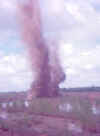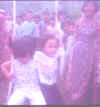|
Working on the River
| |
The pictures on this page are Thumbnails. To see a larger version, click on the
picture.
After building a major part of the base camp, our battalion (15th Combat Engineers), or
at least the company I was a part of began the combat mission of "the combat
engineers". The 9th Division began arriving throughout December and we started
working with the infantry units we supported. A combat Engineer Battalion has four
line companies (if I remember correctly) and a bridge and raft company.
Companies "A", "B" and "C" support line infantry brigades,
"D" Company is a reserve company and "E" Company is a bridge and raft
company. Now if I am incorrect, there is no "E" and "D" is the
bridge company.
I was the platoon leader of the First Platoon of Company "C". We
(company) supported the 3rd Infantry Brigade of the 9th Infantry Division whenever it went
to the field. My platoon supported the 2nd of the 60th Infantry Batallion of the
brigade. Company C moved into the Delta around March or so of 1966 and began
building a Brigade size base camp. The brigade moved in shortly afterwards and than
my platoon left the brigade area and went way out into the boonies with my Infantry
Battalion.
For the better part of the next year, I rarely saw my Company Commander and more or
less operated as a separate combat engineer platoon in support of the infantry. We
did it all from blowing up bunkers to blowing up bridges. We did minesweeping, river and beach assaults, inserting Armored Personnel Carriers
into unfriendly territory, and bridge building. I
regularly flew with my infantry battalion commander to reconnoiter potential ambush and
assault locations.
I wish I could adequately explain what it was like to lead some 40 men in a combat
situation. Given the opportunity, that is the one thing I would do over again.
We had great morale and espirit de' corps. One night we got mortared (well,
we got mortared a lot). Most of the rounds hit a lot of vehicles. The following
night, I took what we had left and snuck into Saigon where all the night clubs were and so
were the rear echelon people. We stole all the military spare tires from their jeeps
which should not have been at the bars anyway and other expendables we could get our hands
on. We left our punctured tires so that the rear echelon people might have
something to talk about later.
We would get momma sans to make Viet Cong flags for us and then go back to a
base camp
and trade them for supplies. Of course we won the prizes of war in daring raids and
hand-to-hand combat. The rear people didn't know any better, or maybe they did.
Here are some pictures of our base camp in the Delta and the connecting pages are
scenes of our river operations and bridge building. All the pictures are
"thumbnails". To see a larger version, double click the small
picture.
 This is the same map on the first page and is a thumbnail. Again, my
platoon was east of Tan An.
This is the same map on the first page and is a thumbnail. Again, my
platoon was east of Tan An.
 |
When we first moved into the battalion site, we lived in
holes. We were there in the dry season, but still we could barely dig more than 2-3
feet without hitting water. My hole was deep enough to put a cot in and my
shelter half over the cot, followed by scrap wood on top of that. Dirt covered the
wood for protection from incoming mortars or artillery. We lived in these holes for
about a month or so and than moved into more "permanent" squad (10 men) sized
tents on dirt pads to stay above the water. |
 |
Many times when we went into the field, we just slept on the
ground in shifts. Other times if we were to be in the field for a week or so, we
pitched tents. In the background is an AVLB tank. An Assault Vehicular
Launched Bridge tank comes up on a blown bridge or ravine or ditch under 60 feet wide and
puts out an aluminum scissored bridge that tanks can cross. They are still using
these in Iraq today. |
 |
After dwelling in a hole, we moved into larger tents.
The army than developed what was termed WABTOC. I have since forgotten the
acronym,
but they were kits of screen and lumber that came in a box. You take the box apart
and you have enough material including door and screening to build a frame over which we
draped our tents. But, being a scrounger, I made out some requisition forms, signed
some ficticious name to them and sent my sergeants to a supply area for metal sheeting to
go on the roof frame. Unfortunately my infantry battalion commander saw us unloading
it and gave me and "either/or" choice. I took the "either" and
gave him mine for his roof. |
 |
We ate a lot of mutton. That was the price the U.S.
paid for getting Australia into the war. Here were are getting our supplies ready to
bake some potatoes in the ground and barbeque some chicken. We took the chicken off
somebody's mess hall. We did a lot of improvisation. Whenever Saigon was
under attack, and the REF's would not leave the safety of their compounds to
supply us, some of my boys went into the city and down to the docks and
begged, borrowed,
or stole whatever we could use. |
 |
Yes, we did have an opportunity to shower. Often we
just washed up while crossing a stream. Sometimes when it rained, we just got, well
you know, and washed. But most of the time, we used the old "pull the cord, get
wet, lather up, pull the cord again rinse off, and get out. |
 |
This is the beginning of the Battalion Command and Control
Center. Reinforced with sand bags on top and all around, the center was made of
"CONEX" containers. These were metal shipping containers that our
equipment was packed in for shipment from the states. The battalion commander
ordered my platoon to put a searchlight tower on top of this. I tried to tell him he
really didn't want to do that, but hey, he was John Wayne afterall. The tower lasted
one night. |
 |
Yes, this is me skinny bod an all. I am leaning against
one of our four mortar bunkers. Like I said, we could not dig so we built above
ground shelters. The coolest place (literally) in the Delta was inside these
bunkers. So our supplies that needed to stay cool when they were not on ice were
placed in the bunkers. Another night when we got hit, the bunker I went to was full
of liquid refreshments. I made a couple of the newest guys crawl out on their
bellies and just told them to stay low. Do you really think we would sacrifice the
liquid refreshments? |
 |
"Lt., I know what I'm doing."
"Sarge," I said, "You've got way too much C-4 on that safe. All we
want to do is rattle the hinges." "Lt.", he said, "let me do
it. And, so I let some cherry sergeant fresh from the states who knew everything
blow the door off a VC safe we just captured. As you can see the safe, the documents, and
everything else went into orbit, and as soon as this newbie volunteered to go on LRRP's
(Long Range Reconnasaince Patrol), we packed him up and said good riddance. A guy
like that could get someone killed. And, he didn't last long as a LRPP and I didn't
want him back with me. |
 |
When we were not doing military missions, we did a lot of
"hearts and minds" missions in local villages. At this site we built a
playground for the one room village school yard. |
 |
God, thank you. I did love my job. |
building.htm This will go to the next page that is a
part of this time and highlights our bridge building
working1.htm This site highlights our river operations

|
 This is the same map on the first page and is a thumbnail. Again, my
platoon was east of Tan An.
This is the same map on the first page and is a thumbnail. Again, my
platoon was east of Tan An.









